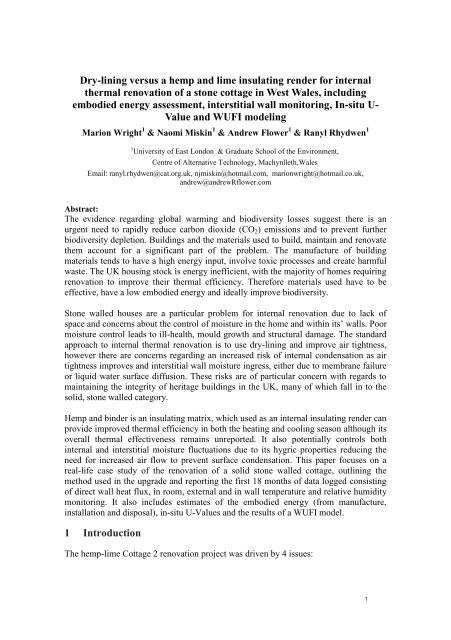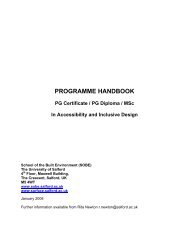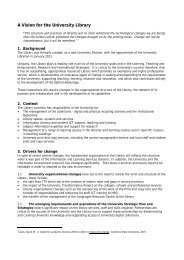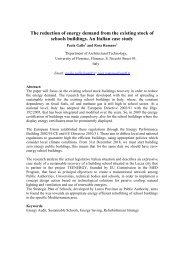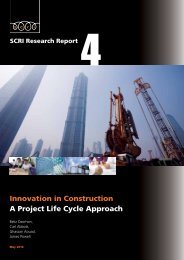Dry-lining versus a hemp and lime insulating render - University of ...
Dry-lining versus a hemp and lime insulating render - University of ...
Dry-lining versus a hemp and lime insulating render - University of ...
Create successful ePaper yourself
Turn your PDF publications into a flip-book with our unique Google optimized e-Paper software.
<strong>Dry</strong>-<strong>lining</strong> <strong>versus</strong> a <strong>hemp</strong> <strong>and</strong> <strong>lime</strong> <strong>insulating</strong> <strong>render</strong> for internalthermal renovation <strong>of</strong> a stone cottage in West Wales, includingembodied energy assessment, interstitial wall monitoring, In-situ U-Value <strong>and</strong> WUFI modelingMarion Wright 1 & Naomi Miskin 1 & Andrew Flower 1 & Ranyl Rhydwen 11 <strong>University</strong> <strong>of</strong> East London & Graduate School <strong>of</strong> the Environment,Centre <strong>of</strong> Alternative Technology, Machynlleth,WalesEmail: ranyl.rhydwen@cat.org.uk, njmiskin@hotmail.com, marionwright@hotmail.co.uk,<strong>and</strong>rew@<strong>and</strong>rewRflower.comAbstract:The evidence regarding global warming <strong>and</strong> biodiversity losses suggest there is anurgent need to rapidly reduce carbon dioxide (CO 2 ) emissions <strong>and</strong> to prevent furtherbiodiversity depletion. Buildings <strong>and</strong> the materials used to build, maintain <strong>and</strong> renovatethem account for a significant part <strong>of</strong> the problem. The manufacture <strong>of</strong> buildingmaterials tends to have a high energy input, involve toxic processes <strong>and</strong> create harmfulwaste. The UK housing stock is energy inefficient, with the majority <strong>of</strong> homes requiringrenovation to improve their thermal efficiency. Therefore materials used have to beeffective, have a low embodied energy <strong>and</strong> ideally improve biodiversity.Stone walled houses are a particular problem for internal renovation due to lack <strong>of</strong>space <strong>and</strong> concerns about the control <strong>of</strong> moisture in the home <strong>and</strong> within its‘ walls. Poormoisture control leads to ill-health, mould growth <strong>and</strong> structural damage. The st<strong>and</strong>ardapproach to internal thermal renovation is to use dry-<strong>lining</strong> <strong>and</strong> improve air tightness,however there are concerns regarding an increased risk <strong>of</strong> internal condensation as airtightness improves <strong>and</strong> interstitial wall moisture ingress, either due to membrane failureor liquid water surface diffusion. These risks are <strong>of</strong> particular concern with regards tomaintaining the integrity <strong>of</strong> heritage buildings in the UK, many <strong>of</strong> which fall in to thesolid, stone walled category.Hemp <strong>and</strong> binder is an <strong>insulating</strong> matrix, which used as an internal <strong>insulating</strong> <strong>render</strong> canprovide improved thermal efficiency in both the heating <strong>and</strong> cooling season although itsoverall thermal effectiveness remains unreported. It also potentially controls bothinternal <strong>and</strong> interstitial moisture fluctuations due to its hygric properties reducing theneed for increased air flow to prevent surface condensation. This paper focuses on areal-life case study <strong>of</strong> the renovation <strong>of</strong> a solid stone walled cottage, out<strong>lining</strong> themethod used in the upgrade <strong>and</strong> reporting the first 18 months <strong>of</strong> data logged consisting<strong>of</strong> direct wall heat flux, in room, external <strong>and</strong> in wall temperature <strong>and</strong> relative humiditymonitoring. It also includes estimates <strong>of</strong> the embodied energy (from manufacture,installation <strong>and</strong> disposal), in-situ U-Values <strong>and</strong> the results <strong>of</strong> a WUFI model.1 IntroductionThe <strong>hemp</strong>-<strong>lime</strong> Cottage 2 renovation project was driven by 4 issues:1
dynamically <strong>and</strong> therefore the rate at which heat is stored <strong>and</strong> propagated through the<strong>render</strong>‘s matrix is in a state <strong>of</strong> constant flux <strong>and</strong> whether this improves or deterioratesoverall thermal performance is unknown.Hemp is fast growing, a useful organic break crop, economically viable withoutdisplacing a food crop (Rhydwen, 2009), relatively low maintenance, requires nobiocides (ADAS, 2005), little if any fertiliser (Murphy & Norton, 2008, Ronchetti,2007), increases biodiversity (Rhydwen, 2006, Small 2002) <strong>and</strong> bio-sequesters 500kg orcarbon per tonne <strong>of</strong> crop produced (Pervaiz 2003), all <strong>of</strong> which give <strong>hemp</strong> very strongenvironmental credentials. The overall environmental impact <strong>of</strong> <strong>hemp</strong> <strong>and</strong> binder is thendetermined by the binder (e.g. <strong>hemp</strong> <strong>and</strong> clay can be composted but can <strong>hemp</strong> <strong>and</strong>cement?) <strong>and</strong> how the <strong>hemp</strong> is grown as mention later <strong>and</strong> discussed in detail by Miskin(Miskin 2010).Hemp <strong>and</strong> binder (e.g. <strong>lime</strong>, cement, <strong>and</strong> clay) is an <strong>insulating</strong> middle weight matrixthat is strongly hygroscopic with a high capillarity <strong>and</strong> moderate moisture bufferingpotential (Arnaud 2009, Evrard 2006, Wilkinson 2009). It is applied wet into form workto create a whole wall or to from an <strong>insulating</strong> <strong>render</strong>. It is easier to achieve an airtightconstruction using ‗wet‘ materials, such as <strong>hemp</strong>-binder <strong>and</strong> the encasing nature <strong>of</strong> cast<strong>hemp</strong>-binder reduces the potential for thermal bridging; both potentially improvingbuilding thermal performance beyond U-value predictions (Bevan & Woolley, 2008).The thermal <strong>and</strong> hygric performance <strong>of</strong> the <strong>hemp</strong> <strong>and</strong> binder matrix has beenextensively investigated. In the Haverhill project two <strong>hemp</strong> homes thermally outperformed two st<strong>and</strong>ard cavity wall homes with a significantly lower U-value (0.58W/m 2 .K <strong>versus</strong> 0.35 W/m 2 .K) over several years yet no definitive conclusions could bedrawn as many cavity walls significantly underperform in practice (Hens 2007, Yates2002, Yates 2003). Evrard <strong>and</strong> Arnaud have reported all the thermal <strong>and</strong> hygricproperties <strong>of</strong> ―Hempcrete‖ (binder <strong>lime</strong> & cement) <strong>and</strong> demonstrated its dynamicthermal properties <strong>and</strong> made estimates <strong>of</strong> its thermal performance under laboratoryconditions <strong>and</strong> within computer models (Evrard, 2005, 2006, 2010 Evrard & De Herde2005, 2006, Arnaud 2009). However modelling has been difficult <strong>and</strong> the results areinconclusive (Arnaud, 2009, Evrard, 2010) as to whether the actual in-situ thermalefficiency <strong>of</strong> <strong>hemp</strong> <strong>and</strong> binder is better or worse than its predicted U-value performance.This in-situ performance is crucial in determining the overall carbon consequences <strong>of</strong><strong>hemp</strong> <strong>and</strong> binder in comparison to other <strong>insulating</strong> techniques. The moisture bufferingeffect <strong>of</strong> <strong>hemp</strong> <strong>and</strong> binder is not fully described as how to assess the potential <strong>of</strong>moisture buffering is still being fully determined (Padfield 2009). Lewis however hasshowed that <strong>hemp</strong> <strong>and</strong> binder does buffer acute pulses <strong>of</strong> moisture (e.g. a kettle boiling)more effectively than DL <strong>and</strong> that it appears to prevent condensation at the solid wallrenovation interface where he recorded an RH <strong>of</strong> 55% for a mock <strong>hemp</strong> renovation on asolid brick wall (Lewis 2009).Therefore there are several questions being raised about the potential for DL tothermally underperform <strong>and</strong> to h<strong>and</strong>le moisture poorly <strong>and</strong> there are still knowledgegaps in the underst<strong>and</strong>ing <strong>of</strong> the dynamic hydrothermal performance <strong>of</strong> <strong>hemp</strong> <strong>and</strong>binder <strong>insulating</strong> <strong>render</strong>s. This study was therefore designed to try <strong>and</strong> add some realworld data to shed more light on these questions <strong>and</strong> to form the reference for a4
computer model to predict the potential for moisture accumulation in the renovationwall.3 Methods3.1 MonitoringThe study consisted <strong>of</strong> the monitoring two test renovation areas comprising applied to asolid-walled slate cottage in Mid-Wales. There is a DL wall with a vapour barrierbehind plasterboard <strong>and</strong> mineral wool insulation with an air-gap before the originalmasonry <strong>and</strong> a wall with a <strong>hemp</strong> <strong>lime</strong> internal <strong>render</strong> (see Figure 1). The ingredients <strong>and</strong>proportions used in the Hemp/Lime mixture were as used in the aforementionedHaverhill development. The proportions <strong>of</strong> the mix were: 37.5kg Lime Binder (ratio: 2Hydrated Lime: 1 NHL 3.5) 5-60 litres Water, 200 litres Hemp shiv. Figure 1 shows themethod used for applying the Hemp-Lime <strong>render</strong> to the stone wall.The 2 walls were constructed adjacent to one another on the north facing rain shelteredwall, with the renovations being <strong>of</strong> equal thicknesses. Platinum ResistanceThermometers (PT100's) error (+/- 0.3 o C) <strong>and</strong> direct voltage output capacitanceRelative Humidity Sensors (Honeywell HIH-4000's) error (+/- 3 RH% 0-100%) wereplaced at intervals throughout the thickness <strong>of</strong> each test wall with mirroring distancesbetween sensors within each wall. On the internal surface <strong>of</strong> each wall, Heat Flux Plate(Hukseflux HFP01) errors (+/- 5%) placed in direct line with the sensors <strong>and</strong> plasteredinto the walls to minimize resistance, absorbance <strong>and</strong> deflection errors. A diagram <strong>of</strong>the experiment is visible in Figure 1. Table 1 shows the U-values <strong>of</strong> the walls.3.2 Embodied EnergyEmbodied energy (carbon) is a measure <strong>of</strong> the energy (CO 2 emissions) associatedwith a product over its entire lifecycle, from ‗Cradle to Grave‘, i.e., supply <strong>of</strong>materials, processing <strong>and</strong> manufacture through lifetime, maintenance <strong>and</strong> end <strong>of</strong>life disposal impacts, derived through Life Cycle Analysis (LCA) assessment(Anderson et al, 2009). Embodied energy <strong>and</strong> carbon data was obtained from avariety <strong>of</strong> literature sources, but predominantly from the ICE database 1 (Hammond &Jones, 2008). The ICE values are derived from LCAs <strong>and</strong> other literature sources,however are quoted for cradle-to-gate rather than cradle-to-grave.1 ICE - Inventory <strong>of</strong> Carbon <strong>and</strong> Energy; a database available from the <strong>University</strong> <strong>of</strong> Bath Sustainable Energy <strong>and</strong>Research Team5
Figure 1: Left the Hemp-Lime being tamped into shuttering, right schematic <strong>of</strong> wall <strong>and</strong> probe positionsInformation on the energy requirements <strong>of</strong> installation <strong>and</strong> initial drying, timescales <strong>and</strong> labourrequirements for <strong>hemp</strong>-binder was taken from the cottage renovation. Due to the wide variancein the gathered data several scenario where created to give the impression <strong>of</strong> the spread <strong>of</strong> thedata, these are described in detail Miskin 2010 however only the mid range is reported here.Table 1. Calculated U-valuesThe <strong>hemp</strong> layer resistance is calculated from the conductivity readings taken using an ISOMET 2104 whichhas an accuracy <strong>of</strong> 5% <strong>and</strong> the other resistance values are taken from st<strong>and</strong>ard literature3.3 In-Situ U-valueBaker has developed a method <strong>of</strong> estimating an In-Situ U-value for a building‘s wallfrom the measured internal wall heat flux <strong>and</strong> the internal <strong>and</strong> external temperaturereadings (Baker 2011) when the temperature difference between inside <strong>and</strong> outside is atleast 10 o C using equation 1.i=tU Value = 1 / (∑ T ins (i) – T out (i) / ∑Q (i)) + R ins (W/m 2 .K) Eqn. 1i=0 i=0Q = Heat Flux (W/m 2 ), T ins (i) = Inside Surface Air Temperature ( o C), T out (i) = Outside Temperature ( o C),R ins = Internal Surface Resistance (0.13m 2 .K/W)To calculate the confidence interval (+/-δU) for the U-value measurements the errorterms were calculated using equation 2 as used by Baker (Baker 2011).δU = (U-U errQ ) 2 + (U-U errTins ) 2 + (U-U errTout ) 2 + (S.D) 2 Eqn.2i=t6
Where U errQ , U errTns <strong>and</strong> U errTout are the U‐values calculated when applying all errors dueto heat flux, internal surface temperature <strong>and</strong> external temperature, respectively <strong>and</strong> U isthe original U-value3.4 WUFI modelThe interstitial moisture control modelling investigation was developed in the moisture<strong>and</strong> heat transfer programme WUFI, from Fraunh<strong>of</strong>er Insitut. The full development <strong>of</strong>the models is covered previously (Flower, 2011). Two models were based on the twowall sections (Fig 1) <strong>and</strong> extended simulations performed. The first 10 months <strong>of</strong>recorded data from the cottage provided verification <strong>of</strong> the models ability toqualitatively represent the patterns <strong>of</strong> RH <strong>and</strong> temperature fluctuations (Fig 2).Figure 2: Simulated Data (red) <strong>versus</strong> real data (blue) in the 36mm mineral wool showing how thegeneral trends are well captured by the model4 Findings <strong>and</strong> discussionFigure 3 shows that the temperature gradient across the DL wall is steepest over theinsulation whereas the <strong>hemp</strong> appears to acting as if homogenous. On the warmest daythe external <strong>and</strong> internal temperature are both higher than the inside the centre <strong>of</strong> thewall by 5-6 o C <strong>and</strong> thus heat will be being drawn into the wall from the inside <strong>and</strong>outside surfaces whereas steady state would only predict a minor flow from outside toinside.From figure 4 it is evident that in both test walls, condensing moisture has beenoccurring constantly in both warm <strong>and</strong> cold conditions. This should be expected in theHemp/Lime wall as the materials are still drying. However the construction <strong>of</strong> the DLwas dry <strong>and</strong> despite the Vapour Barrier the RH behind the DL is constantly ~100% <strong>and</strong>has been so for the entire period <strong>of</strong> data collection suggestive the moisture is beingdrawn into the space from the slate wall.The conditions behind the DL test wall are as predicted <strong>and</strong> as the moisture presentcannot re-evaporate back into the interior environment as it can through theHemp/Lime, it must penetrate the thick stone masonry in order to escape, thusincreasing the risk <strong>of</strong> frost damage to the masonry, interstitial rot <strong>and</strong> mould growth.4.1 Embodied CarbonTables 1, 2 <strong>and</strong> 3 in figure 5 summarise the embodied carbon calculations for <strong>hemp</strong>crete7
<strong>and</strong> DL. Full details <strong>of</strong> the calculations <strong>and</strong> assumptions can be found Miskin (2010).The embodied carbon <strong>of</strong> <strong>hemp</strong>crete represents a ‗most likely‘ current scenario, wherethe <strong>hemp</strong> is grown in monoculture using typical farming practices <strong>and</strong> the <strong>lime</strong> issourced from a centralised facility. Whilst the embodied carbon figure is negative, thisfigure could be much lower (therefore substantially more carbon sequestered), iforganically grown <strong>hemp</strong> <strong>and</strong> <strong>lime</strong> from local kilns were available, <strong>and</strong> better again if aclay binder were used (Miskin, 2010).Figure 3: Temperature pr<strong>of</strong>iles Coldest <strong>and</strong> Warmest Day, slate wall is not to scale.Figure 4: RH in DL <strong>and</strong> Hemp renovations, note how the 36mm <strong>hemp</strong> starts to drop RH indicating thesurface <strong>of</strong> the <strong>hemp</strong> has dried.The walls <strong>of</strong> the cottage that were insulated covered an approximate area <strong>of</strong> 50m 2 .Based on the figures in Tables 2 <strong>and</strong> 3, the embodied carbon for <strong>insulating</strong> the cottageentirely with <strong>hemp</strong>crete is -4 kgCO 2 m 2 <strong>and</strong> entirely with dry <strong>lining</strong> is 903.5 kgCO 2 m 2 . Itis likely that the embodied carbon in the DL would be paid back by savings in CO 2emissions from heating within the lifetime <strong>of</strong> the renovation when compared to <strong>hemp</strong> ifsteady state values are used to calculate the energy losses. However, assuming that the<strong>hemp</strong> can be demonstrated to have an equal or close thermal performance to DL, thecarbon dioxide emissions savings gained through using <strong>hemp</strong>-binder become significantif it were to become widespread. This is demonstrated by assuming that all the UK‘s 7million solid walled buildings were insulated using <strong>hemp</strong>crete.8
Various <strong>hemp</strong>crete combinations were considered (Miskin, 2010), including <strong>hemp</strong>grown organically, using a low impact model (Rhydwen, 2006), use <strong>of</strong> a clay binder,<strong>lime</strong> produced locally, centrally <strong>and</strong> assuming various rates <strong>of</strong> re-carbonation <strong>of</strong> <strong>lime</strong>.Three dry <strong>lining</strong> solutions were also modelled for comparison (mineral wool, EPS <strong>and</strong>PUR).Figure 5: Embodied carbon TablesThe best case <strong>hemp</strong>-binder scenario could potentially sequester over 10 million tonnes<strong>of</strong> CO 2 , whilst the worst case (mineral wool) would emit nearly 10 million tonnes. Themost likely <strong>hemp</strong>-binder scenario however is only just carbon negative. It is obviouslyunrealistic to assume that all solid walled homes would be insulated using the samematerials; however the comparison demonstrates the potential <strong>of</strong> <strong>hemp</strong>-binder <strong>and</strong>indicates the magnitude <strong>of</strong> initial emissions if only synthetic materials are used figure 6.Figure 6: CO 2 emissions from <strong>insulating</strong> the external walls <strong>of</strong> all UK solid wall houses using best, worst<strong>and</strong> most likely <strong>hemp</strong>-binder scenarios <strong>and</strong> dry <strong>lining</strong> solutions.9
Figure 7: The number <strong>of</strong> wind turbines for equivalent carbonIn order to put the carbon sequestration potential <strong>of</strong> <strong>hemp</strong>crete into context, the number<strong>of</strong> 2 MW wind turbines that could be installed for the same amount <strong>of</strong> carbonsequestered if all solid walled UK homes were insulated has been calculated, as shownin Figure 7. An average 2MW wind turbine can provide enough electricity in one yearfor over 1,000 homes (BWEA, 2007). Therefore the 22 thous<strong>and</strong> turbines that could bebuilt with the equivalent amount <strong>of</strong> carbon sequestered under the best case <strong>hemp</strong>-binderscenario is more than required to power the UK‘s 22.2 million homes (CLG, 2009).Even the 900 wind turbines that could be built with the equivalent carbon sequesteredunder the most-likely <strong>hemp</strong>-binder scenario would generate enough electricity to power4.5% <strong>of</strong> UK homes.4.2 In-Situ U-valueAs shown in figure 8, the <strong>Dry</strong> Lining (DL) section <strong>of</strong> the wall has a 22% lower in-situU-value than calculated (Table 1) (figures 8 & 9). However the calculated U-value islikely to be overestimated as the slate wall is treated as a homogenous slate whereasmass walls can contain up to ~30-40% mortar (Baker 2011). This can‘t account forwhole effect as to reduce the overall U-value <strong>of</strong> the wall to the in-situ value theconductivity <strong>of</strong> the slate wall would need to be only to 0.5 W/m.K., considerably lowerthan found for solid walls (Baker 2011). Therefore it seems reasonable to assume thatthe dynamic mass <strong>of</strong> plaster <strong>and</strong> plasterboard is lowering the effective U-value <strong>of</strong> theDL <strong>lining</strong> wall to some degree as well (figure 8 right side).Figure 8. Left: Hemp_Calc. <strong>and</strong> DL_Calc. are expected U-values for walls using there dry conductivitieswith the error days representing a 5% error, Hemp_Meas. <strong>and</strong> DL_Meas. are in-situ U valuesmeasurements. Right: This figure shows a time where the heat flux from the DL wall is negativeindicating there has been thermal storage in the plasterboard <strong>and</strong> plaster. The shaded area shows theperiod <strong>of</strong> negative heat flux.10
Figure 9: The error bars represent the 5% range reported for the heat flux sensors <strong>and</strong> all dry conductivitymeasurements. Qw = Winter Heat Flux total, DL = <strong>Dry</strong> Lining, SS = Qw-Value calculated from SteadyState U-value where Q = - (U-value x (Tout-Tins)), Meas = Measured in-situ value.The DL wall clearly outperforming the Hemp wall (figures 8&9). The Hemp wall isperforming with a U-value effectively 42% worse than predicted. The most likelyreason for this is that the Hemp wall is still drying. This is conclusion is collaborated bythe <strong>hemp</strong> wall‘s in-situ falling overtime (Figure 10) as compared to the DL which isreasonably static suggesting the <strong>hemp</strong> wall is still drying.Figure 10: Change in calculated 14 day U-value overtime. This figure shows the change in average U-value for the Hemp <strong>and</strong> DL walls. The grey shadows are the 95% CI. It can be seen that whereas the DLU-value is relatively static the Hemp U-value slowly declines throughout the winter. The shaded areashows a period after none occupancy when internal RH rose as temperature fell.These results have implications for evaluating the carbon budgets for both wall types, asthe DL is more energy efficient than thought highlighting how using steady state U-value models to estimate thermal performance could lead to significant errors whenassessing actual thermal performance. Clearly at present the high RH behind the DLdoesn‘t appear to be causing any deterioration in thermal performance although thismay change over time if moisture accumulates as the WUFI model suggests. Cottage 2will be continued to be monitored to see how these 2 alternative renovation techniquescontinue to perform <strong>and</strong> to hopefully establish an effective U-value for the Hemp wallonce it is fully dry.4.3 WUFI modelThe simulations that matched the first 10 months <strong>of</strong> real recorded data from the cottageconfirm that the model gives a reasonable representation <strong>of</strong> reality (figure 2). The11
moisture content in the solid wall was set high (85% RH equilibrium state) <strong>and</strong>remained high in both simulations over the10 months. Indian s<strong>and</strong> stone was used forthe slate wall after multiple tests as it has similar properties. In the DL simulation the airgap retains a high humidity near or at 100%, whereas the RH in the mineral woolfluctuates expectedly between 100 % <strong>and</strong> 60% as the internal temperature changes. Inthe <strong>hemp</strong>-<strong>lime</strong> simulation the RH in remained constant at ~100% as it is still drying <strong>and</strong>slower than expected due to the cold room conditions.Next a predictive analysis applying a st<strong>and</strong>ard sine curve from WUFI for indoor climatewith a mean temperature <strong>of</strong> 21 o C <strong>and</strong> RH <strong>of</strong> 50% with amplitudes <strong>of</strong> 1 o C <strong>and</strong> 10%respectively to the DL <strong>and</strong> Hemp models. During a 3 year simulation a 3 year period itis noted that the wall renovation interface MC varies more than in the verification run<strong>and</strong> the model for DL shows a slightly upward to constant trend in moisture <strong>of</strong> the stonewall adjacent to the air gap, whereas in the <strong>hemp</strong>/<strong>lime</strong> model in the third year there is amarked dip in the moisture content in the stone wall. This implies that the dry <strong>lining</strong>model tends to retain moisture in the wall, whereas the <strong>hemp</strong> <strong>lime</strong> tends to drawmoisture out. Two Additional analyses were conducted, first setting the startingmoisture in the wall to a lower level (RH45%) <strong>and</strong> a default MC solid brick wall225mm thick <strong>and</strong> both confirmed these same findings which were more pronounced inthe dryer initial <strong>and</strong> greatest in solid brick figure 11.The animation outputs highlight well the behaviour <strong>of</strong> moisture transfer around theinterfaces between different materials in the insulated wall structure <strong>and</strong> revealed thatsignificant moisture build-up or spikes can occur at the renovation wall interfaces.These spikes are time dependent from application <strong>of</strong> the new internal insulation. In theun-heated cottage condition the interior wall spike for the dry <strong>lining</strong> case occurs atmonth 3 <strong>and</strong> remains till month 5. In the un-heated <strong>hemp</strong>-<strong>lime</strong> a spike also occurs at theinterface between the <strong>hemp</strong>-<strong>lime</strong> <strong>and</strong> the <strong>lime</strong> plaster at month 4 <strong>and</strong> holds till month 6.Figure 10: WUFI simulation with hi9gh initial moisture content in wall section showing the increasingMC <strong>of</strong> the wall behind DL left side <strong>and</strong> the drop in MC <strong>of</strong> the wall behind the Hemp Render.12
Figure 11: Increase MC content in brick behind DL on left, drop in MC in brick behind Hemp rightIt seems the <strong>hemp</strong>/<strong>lime</strong> <strong>render</strong> is very effective at transporting moisture but to be mosteffective it needs to ―breathe‖. It works better with more porous walls e.g. brick, <strong>and</strong>will benefit from ventilation during the drying period. The conditions present in thecottage <strong>hemp</strong>/<strong>lime</strong> project at CAT are possibly some <strong>of</strong> the harshest that might beencountered in the United Kingdom for internal insulation <strong>of</strong> a solid wall. Thesimulations indicate that even in this harsh environment the <strong>hemp</strong> <strong>lime</strong> can be effectiveat reducing moisture load in the wall. However, the prevalent conditions appear tocontribute to abnormally high saturated moisture concentrations at specific points <strong>and</strong>times.The moisture spikes in <strong>hemp</strong>/<strong>lime</strong> are time dependent <strong>and</strong> <strong>of</strong> limited duration. In DL thespikes are associated with a build-up <strong>of</strong> moisture in the wall immediately adjoining thewall/air gap interface. Therefore, moisture spikes in <strong>hemp</strong>/<strong>lime</strong> can regarded as atransient issue whereas in dry <strong>lining</strong> it represents a long term problem than in DL whichcould lead to long term problems5 ConclusionsHemp <strong>and</strong> binder <strong>render</strong>s take time to dry out <strong>and</strong> during this process their dynamicthermal performance as measured with the in-situ U-value is worse than anticipatedwhereas the DL is out performing its U-value predictions by 22% most likely due to anunderestimation <strong>of</strong> the U-value <strong>of</strong> the slate wall in combination with a small thermalmass effect.The RH behind the DL is in keeping with the WUFI model <strong>and</strong> is 100% the whole timeindicating that with a st<strong>and</strong>ard vapour barrier that moisture will build up behind DL <strong>and</strong>in the wall. This could induce rot <strong>and</strong> mould behind the DL <strong>and</strong> the moisture build up inthe wall increase it thermal conductivity worsening thermal performance <strong>and</strong> lead to anincreased risk in frost damage in the wall. Although from the monitoring it isimpossible to discern if the <strong>hemp</strong> <strong>render</strong> will dry out the adjacent wall this did occur inthree separate WUFI models under differing conditions. This is therefore indicative thatthe Hemp <strong>render</strong> will actively dry out an underlying wall which should improve itsthermal performance <strong>and</strong> reduce the risk <strong>of</strong> frost damage despite the coldertemperatures resultant from the insulation effects <strong>of</strong> the <strong>render</strong>.13
It is also clear that <strong>hemp</strong> <strong>render</strong>s will sequester carbon into the renovation wallshowever based on U-values alone a DL method will still save more carbon by fueldisplacement in the long term. However as illustrated on the large scale the carbonsaved into the <strong>hemp</strong> wall could be utilised to <strong>of</strong>fset renewable energy constructionswhich will then save more carbon than just the carbon saved by the increase in thermalefficiency improving the long term carbon savings associated with <strong>hemp</strong> <strong>and</strong> <strong>lime</strong>renovations. Further the U-value is unlikely to be fully representative <strong>of</strong> the true thermalefficiency <strong>of</strong> the <strong>hemp</strong> <strong>render</strong>s as it doesn‘t include thermal bridge reduction, moisturebuffering effects or the drying <strong>of</strong> the external wall. It will therefore be interesting to seehow the <strong>hemp</strong> <strong>render</strong> behaves once it is fully dry. Therefore the main conclusions are;1. <strong>Dry</strong> Lining causes moisture to accumulate in the wall <strong>and</strong> space behind it whichwill lead to rot, internal structural damage <strong>and</strong> increased frost damage.2. Hemp <strong>render</strong>s are not only <strong>insulating</strong> but also dry out the external wall <strong>and</strong> h<strong>and</strong>lemoisture well suggestive that they reduce the risk <strong>of</strong> rot, mould <strong>and</strong> frost damageovertime.3. Hemp <strong>render</strong>s sequester significant amounts <strong>of</strong> carbon dioxide which could beused to <strong>of</strong>fset the embodied carbon <strong>of</strong> renewables in a win win scenario4. U-values can under predict actual performanceThe cottage will continue to be monitored <strong>and</strong> the results reported, a post occupancyevaluation is under way <strong>and</strong> further modelling work is planned to try <strong>and</strong> establish thefuture thermal, hygric <strong>and</strong> moisture buffering performance <strong>of</strong> the <strong>hemp</strong> <strong>render</strong>. All thistogether with work initiated already looking into the composting potential <strong>of</strong> <strong>hemp</strong> <strong>and</strong>binder should allow an inclusive environmental <strong>and</strong> performance <strong>of</strong> assessment <strong>of</strong> <strong>hemp</strong><strong>render</strong>s to be established. Finally from the results it appears that for internal renovationthat <strong>hemp</strong> <strong>and</strong> binder is a viable option that not only improves thermal performance butalso h<strong>and</strong>les moisture effectively. Its wet application is a problem <strong>and</strong> creating a dryapplication from pre-formed blocks is another area <strong>of</strong> future research that is underway.6 AcknowledgementsA warm thank you is extended to the CAT volunteers Simon <strong>and</strong> Murdo who prepared theCottage for renovation, Carole for her tireless <strong>hemp</strong> <strong>and</strong> <strong>lime</strong> mixing, all the other CATvolunteers who tamped <strong>and</strong> carried the <strong>hemp</strong> into place <strong>and</strong> especially to Arthur Butler the CATengineer who was instrumental in ensuring that all the probes <strong>and</strong> data-logger where correctlyinstalled.7 ReferencesADAS (2005) UK Flax <strong>and</strong> Hemp production: The impact <strong>of</strong> changes in supportmeasures on the competitiveness <strong>and</strong> future potential <strong>of</strong> UK fibre production <strong>and</strong>industrial use, ADASCentre for Sustainable Crop Management for DEFRA.14
Allwood J. M., Cullen J.M., Milford R.L., ―Options for Achieving a 50% Cut inIndustrial Carbon Emissions by 2050‖, Environmental Science & Technology,VOL. 44, NO. 6, 2010Anderson, J., Shiers, D. <strong>and</strong> Steele, K. (2009) The Green Guide to Specification. AnEnvironmental Pr<strong>of</strong>iling System for Building Materials <strong>and</strong> Components. FourthEdition. Watford, BRE Press / Wiley BlackwellAnderson K & Bows, A., ―Beyond ‗dangerous‘ climate change: emission scenarios for anew world‖ Phil. Trans. R. Soc. A , vol. 369 no. 1934 20-44, Jan 2011Arnaud, L., 2009. Comparative Study <strong>of</strong> Hygro Thermal Perfomances <strong>of</strong> BuildingMaterials. In Proceedings <strong>of</strong> the 11th International Conference on NonconventionalMaterials <strong>and</strong> Technologies (NOCOMAT 2009). Bath, UK, 2009.Baker P. 2011, ‗Historic Scotl<strong>and</strong> Technical Paper 10‘, Historic Scotl<strong>and</strong>, 2011,http://www.historic-scotl<strong>and</strong>.gov.uk/hstp102011-u-values-<strong>and</strong>-traditionalbuildings.pdf,viewed 30/9/2011Bevan, R. <strong>and</strong> Woolley, T. (2008) Hemp Lime Construction: A guide to building with<strong>hemp</strong> <strong>lime</strong> composites Watford, BRE PressBRE (2005) Energy Use in Homes, Energy Summary report for the Energy SavingTrust <strong>and</strong> DEFRA. Available from:http://projects.bre.co.uk/energyuse/pdf/2001/EnergySummaryReport.pdf (accessed17 December 2009)BS 5250:2002: Code <strong>of</strong> practice for control <strong>of</strong> condensation in buildingsButchart S.H.M., Walpole M, Collen B, Van Strien A, Scharlemann J.P.W, AlmondR.E.A., Baillie J.E.M, Bomhard B, et al, ―Global Biodiversity: Indicators <strong>of</strong> RecentDeclines‖ Science 328, 1164, 2010BWEA (2007) Calculation for Wind Energy Statistics [online] Available from:www.bwea.com/edu/calcs.html (accessed 21 December 2009)Cherret, N., Barrett, J., Clemett, A., Chadwick, M. <strong>and</strong> Chadwick M.J. (2005)Ecological Footprint <strong>and</strong> Water Analysis <strong>of</strong> Cotton, Hemp <strong>and</strong> Polyester. Reportprepared for <strong>and</strong> reviewed by BioRegional Development Group <strong>and</strong> WWF CymruStockholm Environment InstituteCLG (2009) Engl<strong>and</strong> House Condition Survey 2007 Annual Report. Communities <strong>and</strong>Local Government. Available from:http://www.communities.gov.uk/documents/statistics/pdf/1346262.pdf (accessed 30October 2009)DEFRA (2009b) Guidelines to DEFRA / DECC GHG Conversion Factors for CompanyReporting Version 2 Available from:www.defra.gov.uk/environment/business/reporting/pdf/20090928-guidelines-ghgconversion-factors.pdf(accessed 21 December 2009)EST (2009) Solid Wall Insulation [online] Available from:http://www.energysavingtrust.org.uk/Home-improvements-<strong>and</strong>-products/Homeinsulationglazing/Solid-wall-insulation (accessed 8 October 2009)Evrard, A., 2006. Sorption behaviour <strong>of</strong> Lime-Hemp Concrete <strong>and</strong> its relation to indoorcomfort <strong>and</strong> energy dem<strong>and</strong>. In PLEA. Geneva, Switrzerl<strong>and</strong>, 2006.Evrard, A. & De Herde, A., 2005. Bioclimatic envelopes made <strong>of</strong> Lime <strong>and</strong> HempConcrete, proceedings de la conférence CISBAT 05 donnée à l‘EcolePolytechnique Fédérale de Lausanne, pp. , septembre 2005, co-auteur : A. DeHerde. In proceedings de la conférence CISBAT 05 donnée à l’Ecole PolytechniqueFédérale de Lausanne. Lausanne, 2005. CISBAT.15
Evrard, A. & De Herde, A., 2006. Dynamical interactions between heat <strong>and</strong> mass flowsin. Research in Building Physics <strong>and</strong> Building Engineering, pp.69-76.Evrard, A & De Herde, A., Hygrothermal Performance <strong>of</strong> Lime-Hemp WallAssemblies, Journal <strong>of</strong> Building Physics Vol. 34, No. 1—July 2010Flower, A.R., 2009. Hemp Lime <strong>and</strong> Cellulose Internal Insulation for Solid Walls.Course work. Machynlleth: Centre for Alternative Technologies Centre forAlternative Technologies.Fraunh<strong>of</strong>er IBP, 2001. IBP/S<strong>of</strong>tware/WUFI. [Online] Available at:http://www.wufi.de/index_e.html [Accessed 7 July 2010].Fraunh<strong>of</strong>er IBP, 2010. Moisture Transport In Building Materials. [Online] Available at:http://www.hoki.ibp.fraunh<strong>of</strong>er.de/wufi/wufi_frame_e.html [Accessed 28 June2010].Hammond, G. <strong>and</strong> Jones, C. (2008) Inventory <strong>of</strong> Carbon <strong>and</strong> Energy (ICE) version 1.6a.Sustainable Energy Research Team, Department <strong>of</strong> Mechanical Engineering,<strong>University</strong> <strong>of</strong> Bath, UK. Available from: www.bath.ac.uk/mech-eng/sert/embodied(accessed 12 July 2009)Hansen, J & Sato M, ―Paleoclimate Implications for Human-Made Climate Change‖,NASA 2011,http://www.columbia.edu/~jeh1/mailings/2011/20110118_MilankovicPaper.pdfAccessed Oct 2011Hens H., A. Janssens, W. Depraetere, J. Carmeliet, J. Lecompte ―Brick Cavity Walls: APerformance Analysis Based on Measurements <strong>and</strong> Simulations‖ Journal <strong>of</strong>Building Physics; 31; 95; 2007Hukseflux Thermal Sensors, 2011 ‗APPLICATION AND SPECIFICATION OF HEATFLUX SENSORS Version 9904‘http://www.hukseflux.com/downloads/thermalScience/applicAndSpec.pdf viewed2011.International Energy Agency (IEA), ―Integral Building Envelope PerformanceAssessment‖ Technical Synthesis Report, IEA ECBCS Annex 32, 2003Jackson, J. Li, Y. Murrells, T. Passant, N. Sneddon, S. Thomas, J. Thistlethwaite, G.Dyson, K. Cardenas, L. Greenhouse gas inventories for Engl<strong>and</strong>, Scotl<strong>and</strong>, Wales<strong>and</strong> Northern Irel<strong>and</strong>: 1990 – 2007, Pivot Tables.2009Künzel, H.M., 1995. Simultaneous Heat <strong>and</strong> Moisture Transport in buildingComponents. Stuttgart: Fraunh<strong>of</strong>er IBP.Künzel, H.M., 1998. <strong>Dry</strong>ing <strong>of</strong> Wall Structures with Insulation Systems. Bauphysik,pp.18-23.Künzl, H.M., 1998. Effect <strong>of</strong> interior <strong>and</strong> exterior insulation on the hygrothermalbehaviour <strong>of</strong> exposed walls. Materials <strong>and</strong> Structures/Materieux et Constructions,31(H206), pp.99-103.Künzl, H.M. & Kießl, K., 1996. <strong>Dry</strong>ing <strong>of</strong> brick walls after impregnation.Baust<strong>and</strong>setzen, (2), pp.87-100.Kymalainen, H. <strong>and</strong> Sjoberg, A. (2008) ‗Flax <strong>and</strong> Hemp Fibres as Raw Materials forThermal Insulations‘. Building <strong>and</strong> Environment 43 pp1261-1269Joel Lewis (January 2010) Managing Moisture in the Renovation <strong>of</strong> the Solid WallHousing Stock. A comparative study <strong>of</strong> Hemp-<strong>lime</strong> against <strong>Dry</strong>-<strong>lining</strong> (MScThesis) Thesis, MSc. Architecture: Advanced Environmental <strong>and</strong> Energy Studies,<strong>University</strong> <strong>of</strong> East London.16
Miskin, N. (2010) The Carbon Sequestration Potential <strong>of</strong> Hemp-binder: A study <strong>of</strong>embodied carbon in <strong>hemp</strong>-binder compared with dry <strong>lining</strong> solutions for <strong>insulating</strong>solid walls. Thesis, MSc. Architecture: Advanced Environmental <strong>and</strong> EnergyStudies, <strong>University</strong> <strong>of</strong> East London.Murphy, R.J. <strong>and</strong> Norton, A. (2008) Life Cycle Assessments <strong>of</strong> Natural Fibre InsulationMaterials Final Report for National Non Food Crops Centre <strong>and</strong> DEFRAPadfield T, Jensen L. A., Humidity buffer capacity <strong>of</strong> unfired brick <strong>and</strong> other buildingmaterials, 2009,http://www.conservationphysics.org/wallbuff/buffer_performance.pdf accessed Oct2011.Pervaiz M. ―Carbon storage potential in natural fiber Composites‖; Resources,Conservation <strong>and</strong> Recycling 39; 325_/340; 2003Ronchetti, P. (2007) The barriers to the mainstreaming <strong>of</strong> <strong>lime</strong>-<strong>hemp</strong>: A systemicapproach. Thesis, MSc. Sustainable Development, Dublin Institute <strong>of</strong> TechnologyRhydwen, G. R. (2006) A model for UK <strong>hemp</strong> cultivation <strong>and</strong> processing to supply thebuilding industry with hurds for <strong>hemp</strong> <strong>and</strong> <strong>lime</strong> concrete <strong>and</strong> fibres for insulationbats, with the ethos <strong>of</strong> environmental protection as a priority. Thesis, MSc.Architecture: Advanced Environmental <strong>and</strong> Energy Studies, <strong>University</strong> <strong>of</strong> EastLondonRhydwen, R. (2009) Lecture: Hemp / Lime (1a) History <strong>and</strong> Background to <strong>hemp</strong>(Cannabis Sativa L.) AEES Module C3 Study Book, May 2009 pp85-103Rockström, J.,Steffen W., Noone K., Persson A, Chapin III F. S., Lambin E.F., LentonT.M., Marten Scheffer M. et al ―A safe operating space for humanity.‖ Nature, 461,472-475, 2009.Sedlbauer, K. & Künzl, H.M., 2000. Frost dmage <strong>of</strong> masonry walls - a hygrothermalanalysis by computer simulation. Journal <strong>of</strong> Thermal Envelope <strong>and</strong> BuildingScience, 23, pp.277-81.Small, E. Hemp: ―A new crop with new uses for North America‖. p. 284–326. In: J.Janick <strong>and</strong> A. Whipkey (eds.), Trends in new crops <strong>and</strong> new uses. ASHS Press,Alex<strong>and</strong>ria, VA.2002Toman, J., Vimmrola, A. <strong>and</strong> Cerny, R. (2009) ‗Long-term on-site assessment <strong>of</strong>hydrothermal performance <strong>of</strong> interior thermal insulation systems without watervapour barrier‘. Energy <strong>and</strong> Buildings 41 pp 51-55Wilkinson, S. (2009) A study <strong>of</strong> the moisture buffering potential <strong>of</strong> <strong>hemp</strong> incombination with <strong>lime</strong> <strong>and</strong> clay based binders. Thesis, MSc. Architecture:Advanced Environmental <strong>and</strong> Energy Studies, <strong>University</strong> <strong>of</strong> East London.Woolley, T. (2009) Lecture: Sustainable Building Materials (3) - Sustainable InsulationMaterials. AEES Lecture Notes pp 197-210Yates, T., 2002. Final Report on the. Client Report. Watford: BRE.Yates, T., 2003. Thermogaphic Inspection <strong>of</strong> the Masonry <strong>and</strong> Hemp Houses -Haverhill, Suffolk. Client Report. Garston: BRE.Zirkelbach, D., Holm, A. & Künzel, H.M., 2005. Influence <strong>of</strong> temperature <strong>and</strong> relativehumidity on the durability <strong>of</strong> mineral wool in ETICS. In 10DBMC InternationalConference On Durability <strong>of</strong> Building Materials <strong>and</strong> Components. LYON, 2005.17


